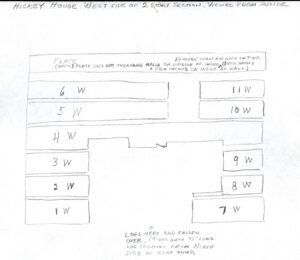Many readers are likely familiar with open air and living history museums. Here in Indiana, for example, school groups and the general public visit attractions such as Conner Prairie, Historic Prophetstown, and the Pioneer Village at Spring Mill State Park to learn about lifeways and folk traditions of the past in recreated farmsteads, towns, or villages. However, did you know that Indiana University once had ambitious plans to erect its own open air museum near the Bloomington campus? Here at the Indiana University Archives, you are welcome to stop by and dig through the Warren E. Roberts papers, fully processed in 2010, to learn more about Roberts’ proposed “Outdoor Museum of Early Indiana Life” or “Pioneer Village.”

Warren E. Roberts, born in Maine in 1924, first came to Indiana University in 1948 to study for his M.A. in English, which he received in 1950. After redefining his academic interests, Roberts next chose to work towards his PhD in Folklore and finished in 1953, which made him the first individual in the United States to earn a PhD in this field of study. Over the next several decades, Roberts immersed himself in his studies and effectively helped to found the study of folklore and material culture as it exists in the United States. His research interests and accomplishments far exceed the limits of this blog post, though it is worth focusing on one of his most influential efforts in terms of Indiana University’s history–his research concerning traditional Indiana culture.

During his time spent studying in Norway courtesy of a Fulbright Award, Roberts developed an interest in open air museums, first conceived in Norway in the late 1880s, which feature vernacular architecture and material culture to educate museum-goers on past lifeways. Upon his return to the United States, Roberts sought to evoke a similar experience with the goal of preserving and enlivening traditional lifeways of nineteenth century Indiana settlers, thus educating modern locals and visitors on “the old traditional way of life.”

Roberts surveyed south central Indiana in search of buildings which embodied the rural architectural traditions of the region, with the hope of finding structures to include in an eventual museum. With support of Indiana University administration, he visited, photographed, and took notes on over 700 log buildings to learn traditional aesthetics. Over the course of his survey, he acquired a number buildings through donations or at a low cost, which were deconstructed and stored awaiting funding to bring the Museum’s plans to fruition. Modest log village homes, a church, a doctor’s office, a general country store, and farm buildings–all furnished with period pieces and tools–were planned for the museum, as was a general visitor’s center. Unfortunately for Roberts, widespread enthusiasm for the project waned by the mid-1970s, and with it the chance for sufficient financial support.

Now in 2011, only the memory of Robert’s Museum of Early Indiana Life remains, along with his various photographs, notes, pamphlets, architectural drawings, and correspondence preserved at the IU Archives. Through Robert’s papers, one may explore his local Indiana research in support of the Museum, most of which he pursued in the 1960s-1970s. Extensive records on covered bridges and log cabin buildings, as well as materials documenting interactions with open air museums established throughout the United States and Europe, make it possible to envision the reaches of Robert’s aspirations. Furthermore, the Indiana University Department of Folklore & Ethnomusicology maintains a website where users can explore a virtual version of Warren Roberts’ Museum of Early Indiana Life through photographs, drawings, and historic summaries. It certainly doesn’t create the enveloping experience of Roberts’ dreams, but it does lend an insightful perspective for a rainy day.
1 Comment
Hi There Ajankows,
This might be off topic, however, Memorial Stadium is the name of the football stadium that the University of Indiana (IU) Hoosiers play their home football games in. The popular campus fixture in Bloomington, Indiana is commonly referred to by a couple of endearing nicknames by students, alumni, and fans in general. The most popular of these nicknames are “The Rock” and “The House.”
Cheers